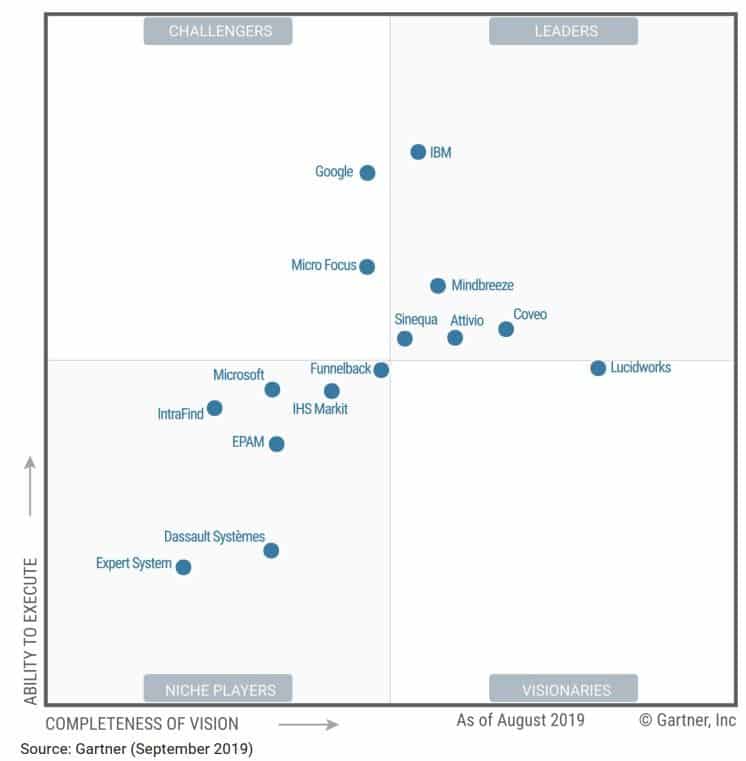13 Artificial Intelligence Trends for Investors to Watch
Table of contents
Table of contents
- The Gartner Hype Cycle for Artificial Intelligence, 2020
- 28 Categories of Artificial Intelligence
- Transformational Artificial Intelligence
- Augmented Intelligence
- Composite AI
- Generative AI
- Intelligent Applications
- High Benefit Artificial Intelligence
- Insight Engines
- Knowledge Graphs
- Small Data
- Things as Customers
- AI Governance, Responsible AI, and Digital Ethics
- Two AI Megatrends
- The Democratization of AI
- The Industrialization of AI
- A Hype Cycle for Hype Cycles
- Conclusion

“As soon as it works, nobody calls it AI anymore.” Those were the words of John McCarthy, a computer scientist who is considered one of the founding fathers of artificial intelligence. It makes you wonder when artificial intelligence (AI) will stop being a disruptive technology and just become something everyone uses to do things more efficiently. One way to gauge the maturity of any given technology is to see where it sits on the Gartner Hype Cycle. As it turns out, artificial intelligence has spawned its own Gartner Hype Cycle.
The Gartner Hype Cycle for Artificial Intelligence, 2020

On the far right sitting alone on the Plateau of Productivity are GPUs. They’re what made NVIDIA the largest semiconductor manufacturing company in the world, and just one of 28 different categories of artificial intelligence identified by the MBAs over at Gartner.
A few months ago, we wrote about 9 Technology Trends You Should Know For 2021 and noted how the nomenclature of technology changes faster than the technology itself. Are there really 28 different categories of artificial intelligence, or is this just another example of what happens when you give research analysts too much organizational plasticity?
28 Categories of Artificial Intelligence
We’re quite bullish on artificial intelligence, holding five AI stocks in the Nanalyze Disruptive Tech Portfolio. That’s a small number when you consider that CB Insights recently identified more than 6,000 AI startups trying to work their way towards a liquidity event. As investors, we need to stay on top of what new technologies are emerging as AI continues to make itself smarter and find new niches to expand into. By examining Gartner’s categorizations, we can see what new applications for AI are emerging.
In their report, Gartner segments each of the 28 categorizations into a matrix that shows which will be most beneficial to mankind and what timeframe we should expect the benefit.

Each of the above rows describes the degree to which these technologies will benefit mankind – “transformational”, “high”, “moderate”, or “low”. Fortunately, the “low” row contains no categories. That’s good, because if a technology provides minimal benefits, why invest in it?
In the “moderate” row we see data labeling and FPGA accelerators. We recently expressed concern about what data labeling companies will do once all the AI algorithms have been sufficiently trained. We’ve also looked at how FPGAs might be applied to artificial intelligence.
Let’s take a closer look at the categories of artificial intelligence that are expected to have a “transformational” benefit for mankind.
Transformational Artificial Intelligence
Out of the 28 trends listed, Gartner identified 13 that they considered would have transformational benefits. For investors, these are the technologies that should have the greatest economic impact. You cannot have exponential returns without creating exponential value.
| TRANSFORMATIONAL | ||
|---|---|---|
| two to five years | five to ten years | more than ten years |
| Augmented Intelligence | AI Marketplaces | Artificial General Intelligence |
| Chatbots | Natural Language Processing | Autonomous Vehicles |
| Composite AI | Neuromorphic Hardware | |
| Deep Neural Networks | ||
| Edge AI | ||
| Generative AI | ||
| Intelligent Applications | ||
| Machine Learning |
In the above table, we’ve provided links to past articles which discuss these various categories of AI. We’ve also added topics to our editorial queue for areas that we need to refresh, such as the progress being made by autonomous vehicle startups.
Let’s look at some new terms we haven’t used in any of our past articles.
Augmented Intelligence
This is where machines and AI work together in a manner that’s reminiscent of human-in-the-loop, but less about training an algorithm and more about working together with it. For example, the advances being made in medical imaging mean that doctors won’t be replaced. Instead, the AI algorithms will provide a second opinion. “Are you sure you want to do that?” the AI algorithm might ask the doctor when a decision is being made which the AI algorithm disagrees with. Neither AI nor people can accomplish the task without each other, and the human remains at the center of partnership.
Composite AI
Some of this stuff you’re better off smoking a big fat joint before reading. That won’t help you understand the material any better, it just makes it less painful. Best we can glean is that in the AI world, composite AI is the equivalent of working smarter not harder. Says the report, “the benefits of composite AI can only be achieved through the creative artisanship of AI experts.” Just be warned, if you’re not one of those AI artisans, this may come across as the sort of stuff highly-paid management consultants try to peddle which never leads to anything actionable.
Generative AI
As AI matures, it’s increasingly being used to create completely new things. For example, you’ve probably seen pictures going around of AI-generated people who don’t actually exist.

There are also generative AI algorithms that generate movie scripts, create fashion, or compose music.
Intelligent Applications
Gartner talks about how enterprise application vendors are embedding AI technologies within their offerings to improve the customer experience leading to “intelligent applications.” The takeaway for investors might be that any enterprise software company out there that isn’t using AI now is being quickly passed up by their competitors. That can change very quickly though. Large companies can quickly acquire small disruptive technology companies once the kinks have been worked out.
High Benefit Artificial Intelligence
The AI category that’s expected to reach maturity in under two years is GPUs of the type manufactured by NVIDIA (NVDA), a company that’s now the world’s biggest semiconductor company. Let’s look at the other AI technology categories that are expected to reap high benefits for mankind.
| HIGH BENEFIT | ||
|---|---|---|
| two to five years | five to ten years | more than ten years |
| AI Cloud Services | Digital Ethics | Things as Customers |
| AI Developer and Teaching Kits | Knowledge Graphs | |
| AI Governance | Responsible AI | |
| Computer Vision | Small Data | |
| Decision Intelligence | Smart Robots | |
| Deep Neural Network ASICSs | ||
| Insight Engines |
Let’s look at some of the new terms in the above table.
Insight Engines
Sitting alone on the Slope of Enlightenment we have Insight Engines, a category that’s so mature it has a Magic Quadrant describing all the companies that dabble in it.

This is about using artificial intelligence to understand all of a company’s data so that you might be able to conduct enterprise-wide searches for things. Here’s a good example given by Gartner:
For example, rather than simply link to an HR employee profile, an insight engine can present a richer set of information such as employee social connections, their upcoming meetings, outstanding IT support tickets, and so on.
Insight engines can also be directed outside an organization as well. For example, if your employee worked in R&D then you might be able to query all publications of patents they were assigned.
Knowledge Graphs
We first talked about knowledge graphs in a piece we did about four years ago titled Diffbot: Extracting Structured Data from the Internet. Basically, it’s about putting some structure around disparate data sources, whether structured or unstructured, so you can then query it. Imagine taking the entire World Encyclopedia and structuring it so that you could ask it questions like “how tall is the Eiffel Tower” or “how old was Thomas Jefferson when he died?” Both these questions are easily answered by The Google Knowledge Graph today.
Small Data
This is about training models using less data. It’s not just for companies that don’t have access to big data, it’s also about being able to create useful algorithms without having to spend so much money training them. (Computing power is now a commodity which becomes the cost of training a model.) Solutions include creating synthetic data or using techniques like federated learning to access data that would otherwise be off limits.
Things as Customers
“Today there are more internet-connected machines with the potential to act as customers than humans on the planet,” says Gartner. As machines become smarter, they may start conducting their own purchases. The simplest example might be a printer that orders ink when it’s running low. A more modern example might be using smart contracts in the supply chain so that the flow of payments is automated. Industry leaders believe that by 2030, at least 25% of all consumer purchases and business replenishment requests on average will be delegated to machines. The below slide from Gartner is supposed to show how the customer experience changes as a result.

In reality, it’s just an excellent example of a skill you quickly learn in business school – how to create great-looking slides that convey absolutely nothing of value.
AI Governance, Responsible AI, and Digital Ethics
“AI governance” is to AI what risk management is to investing. It’s about having frameworks in place to manage unintended consequences. Note that this is different from those on Twitter who want a say in how AI is developed because they don’t like the outcomes, yet lack the ability to do the work themselves. Since many AI technologies are so new, we’re sailing in uncharted waters when it comes to ethics – thus the term “digital ethics.”
“Responsible AI” is about making sure AI isn’t being used for nefarious purposes such as the concerns Elon Musk has raised. It’s not about companies letting their employees dictate what business areas they ought to engage in. Many of today’s tech workers think they’ve been hired for their activism, and the words “fiduciary responsibility” aren’t in their lexicon. Rarely are these people reasonable to work with, so many end up being shown the door.
Two AI Megatrends
As if 28 categories of AI weren’t enough, Gartner has then encapsulated the entire thing within two overarching megatrends. A megatrend is what happens when you combine the words “mega” and “trend.” It looks really good on a whiteboard, and it also provides the authors of the report with an opportunity to insert references to the pandemic which are all but required for marketing collateral these days.
The Democratization of AI
This is what it says on the tin. AI is no longer restricted to subject matter experts with pocket protectors and coke-bottle glasses. In next year’s technology trends, Gartner listed democratization of expertise which is pretty much the same as the “intelligent composable business” which is probably described by half a dozen other posh-sounding terms. In the real world, companies like ThoughtSpot and DataRobot are helping to democratize AI by making its powers available to corporate citizens everywhere. (Both of these unicorns have now raised over $700 million each.)
The Industrialization of AI
According to a recent Gartner survey, the C-suite is steering AI projects, with nearly 30% of projects directed by CEOs. This means that AI solutions are expected to be industrial strength, tried and true, with all the kinks worked out. An example might be the large-scale AI implementations that C3 is engaged in – multi-million dollar contracts with some of the biggest players across multiple industries. It’s all about accelerating adoption and growth so that the laggards can catch up with the early adopters.
A Hype Cycle for Hype Cycles
Perhaps the biggest takeaway from Gartner’s AI Hype Cycle was how much the hype has grown in just the last year. Hype cycles are now birthing even more hype cycles. There’s now the “Hype Cycle for Data Science and Machine Learning, 2020,” which is accompanied by the “Hype Cycle for Natural Language Technologies, 2020.” We almost need a hype cycle to track the hype cycles.
Some AI technologies like “VPA-enabled wireless speakers” have matured and dropped off. Others like robotic process automation are no longer considered AI by Gartner, perhaps because they’re now referring to that as hyperscience. Cognitive computing is now obsolete for reasons we can’t easily decipher. The whole thing is quite overwhelming, and it’s a good reminder of why we prioritize revenue growth above all else. Nobody cares how great your idea is, or what you choose to call it. The proof is in the double-digit revenue growth.
Conclusion
As AI technologies develop and mature, they’ll find even more usefulness, and the nomenclature will expand to include even more terms. As investors, we need to separate the substance from the hype. If as Mr. McCarthy says, we stop calling it AI when it works, then that’s about the time we want to start investing in it.
Wondering which five AI stocks we’re holding? Check out “The Nanalyze Disruptive Tech Portfolio Report” which lists our five AI stocks along with 20 more disruptive tech stocks we love so much we’ve invested in them ourselves. Now available for Nanalyze Premium annual subscribers.










Do you know any EFT with unlisted AI companies (eg AI startups) ?
I find it frustrating most interesting AI companies are unlisted, which makes it impossible to invest in.
We don’t know of any ETFs covering unlisted AI startups.
We’ve covered Draper Esprit – a stock that provides exposure to some AI startups – which you already know about.
Just remember, with more than 6,000 AI startups out there, expect to see many failures along with success stories. Nothing is a sure investment. Just look how solar treated investors as a thesis (though this year, that’s turned around). Sure, AI stocks like NVIDIA have fared well, but nothing is a given. It’s increasingly important to figure out what NOT to invest in as it is to figure out what TO invest in. Pundits seem to do too much of the latter.
ABCL – Abcellera – just listed yesterday. +194% on first day of trading.
AI company involved in drug discovery. Backed by Bill Gates and Peter Thiel.
Cheers for that Stan. The performance number you’ve given was relevant for anyone who held shares of the company prior to the IPO. Everyone who bought shares of that company on the day it began trading paid a massive premium for the privilege.
We were considering covering AbCellera but felt there was too much “short-term pandemic thesis” going on. Instead, we opted to publish a piece on why people should be extremely cautious about the irrational behavior on exhibit when it comes to IPOs: http://nanalyze.donebox.hu/2020/12/investing-disruptive-tech-ipos-2021/
We may cover AbCellera once the dust has settled.
So far it fell 24%. It may be a good buy once it reaches the bottom.
BrainChip (ASX:BRN) signs IP agreement and sends processor to NASA for evaluation
https://themarketherald.com.au/brainchip-asxbrn-signs-ip-agreement-and-sends-processor-to-nasa-for-evaluation-2020-12-24/
Hi Stan.
Appreciate you keeping us up to date with the daily stream of press releases from Brainchip but let’s not do that. People can go read for themselves. Press releases and $6 won’t get you a beer at Hooters these days so let’s just post real news – like meaningful revenue growth.
We really do appreciate having you as a subscriber. It means a lot. You’re always engaging us with questions and comments which we appreciate and never want to discourage. Our goal is always to maximize our usefulness for paying subscribers so we’re all rooting for the same team.
Thanks man!
Fever detection system sales driving Predictiv AI’s revenue higher
Ticker: INOTF
Stay away from those nano caps man. Most are absolute rubbish. Don’t try to find the needle in the haystack when there is so much less riskier stuff you could be looking at instead.